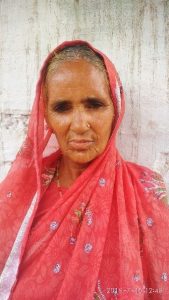A small community living in Kymore, Madhya Pradesh – the heart of India – fights every day for fresh and asbestos free air. Their source of income is in fact a slow poison that they are doomed to breathe every day. The operations of Everest Industries Ltd. are sole reason for it. Everest Industries produce asbestos cement (AC) sheet under the brand name of Everest, having a wide spread business across the country.
The country with 1.35 billion population, out of which 48.4% is female population, is still unwilling to address the gender neutrality. The women are the second most exposed victim of asbestos fibre, remain largely unnoticed. Women are not mentioned as a major stakeholder with regard to Asbestos Related Disease in the OSH laws except as dependent of the worker.
Swara Bee
|
During the field work conducted, several sociol and environmental impacts were observed ‘in and around’ Kymore. In order to understand the nature, extent and magnitude of asbestos toxicity, medical camp was organized at Kymore in 2018. Victims from as far as Gujrat, Bihar and Chattisgarh came for diagnosis in this medical camp.
The severe impacts disclosed during diagnosis are result of absence of a health regulatory mechanism by the government. AC industry is by far the largest user of asbestos fibre worldwide, accounting for about 95% of all uses. Frequency of air quality monitoring of stack emission, static background dust sampling at project boundary should be done along with the standard method specified in ISO 10397:1993 (E), using a fibre count technique, for the assessment of fibre concentrations in flowing gas streams in ducts, chimneys or flues from industrial processes using asbestos should be followed. But it seems nothing of that sort is being followed in the plant.
The white dust seen all along the place is clear proof that norms and regulations are not abided by. The male workers are primary victims as they work directly in the factory, handling raw or processed fibre. But the women who have never worked in the factories, too, have not remained untouched with the disease.
A report published in November 2016 by National Center for Biotechnology Information (NCBI), states that “Non-occupational exposure to asbestos may explain about 20% of the mesotheliomas in industrialized countries, but it does not seem possible to estimate the number of lung cancers caused by these circumstances of exposure.” The disability percentage seen in the identified secondary victims in Kymore was as high as 40%, making the secondary victims more vulnerable to mesothelioma in the long run.
Most of the women, now diagnosed as positive Asbestos Related Diseases (ARD), don’t even understand how they got exposed to the fibre. It took some time for them to realize that doing laundry for the spouse or someone working in the manufacturing unit can expose them to the fibre and cause the disease. The clothing of workers handling asbestos products provided a significant risk for second hand exposure. Owing to jagged structure of Asbestos fibres, the microscopic particles easily attach to clothes. Thus a person, handling or washing these work-clothes, is likely to experience indirect exposure. There is also a high probability of environmental exposure as the asbestos waste was dumped by the company in residential areas and people continue to reside in the vicinity of landfill till today.
Many of these women used to remain within their homes and wondered how they can be ill because of something they never touched. Hence it is important to legally recognize these victims of environmental exposure to bring them in the orbit of redressal system.
Author – Pooja Gupta


Recent Comments